Poached Chicken Breast
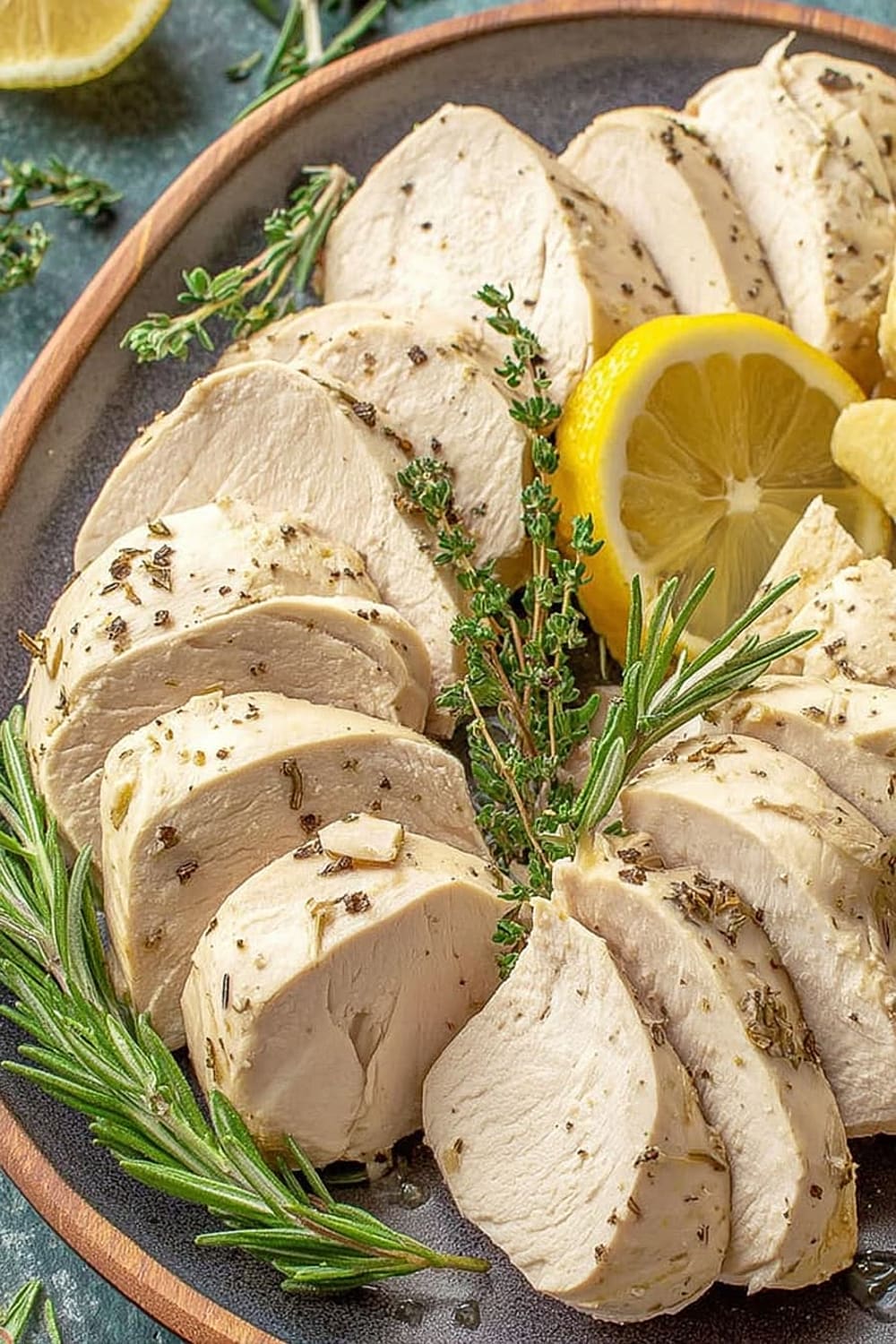
This is the recipe that turns you into the friend everyone calls when they need something that looks fancy but won’t leave you stress-sweating in the kitchen.
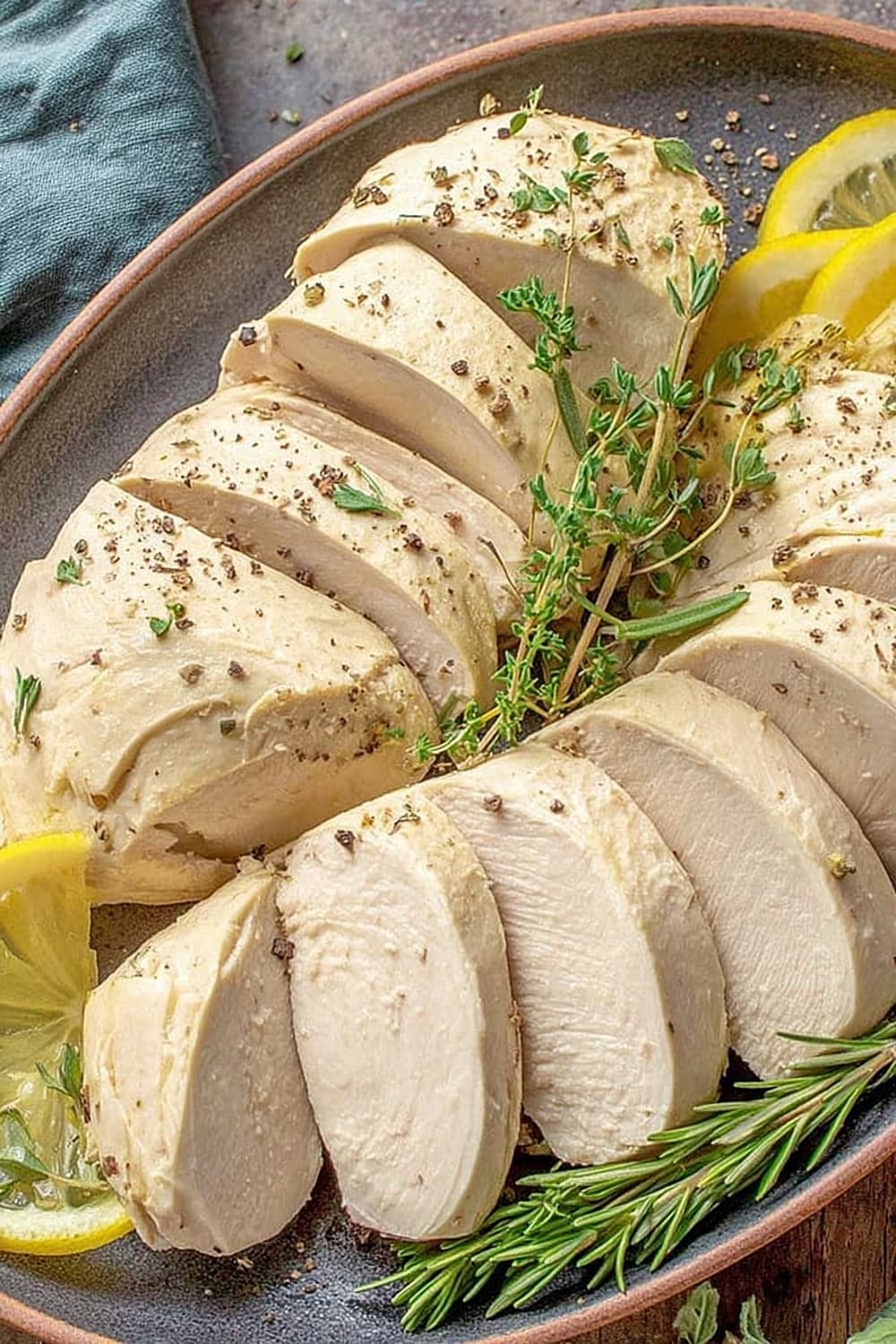
Poached chicken breast is basically the elegant cousin of boiled chicken, except it actually tastes amazing and makes you look like you know what you’re doing.
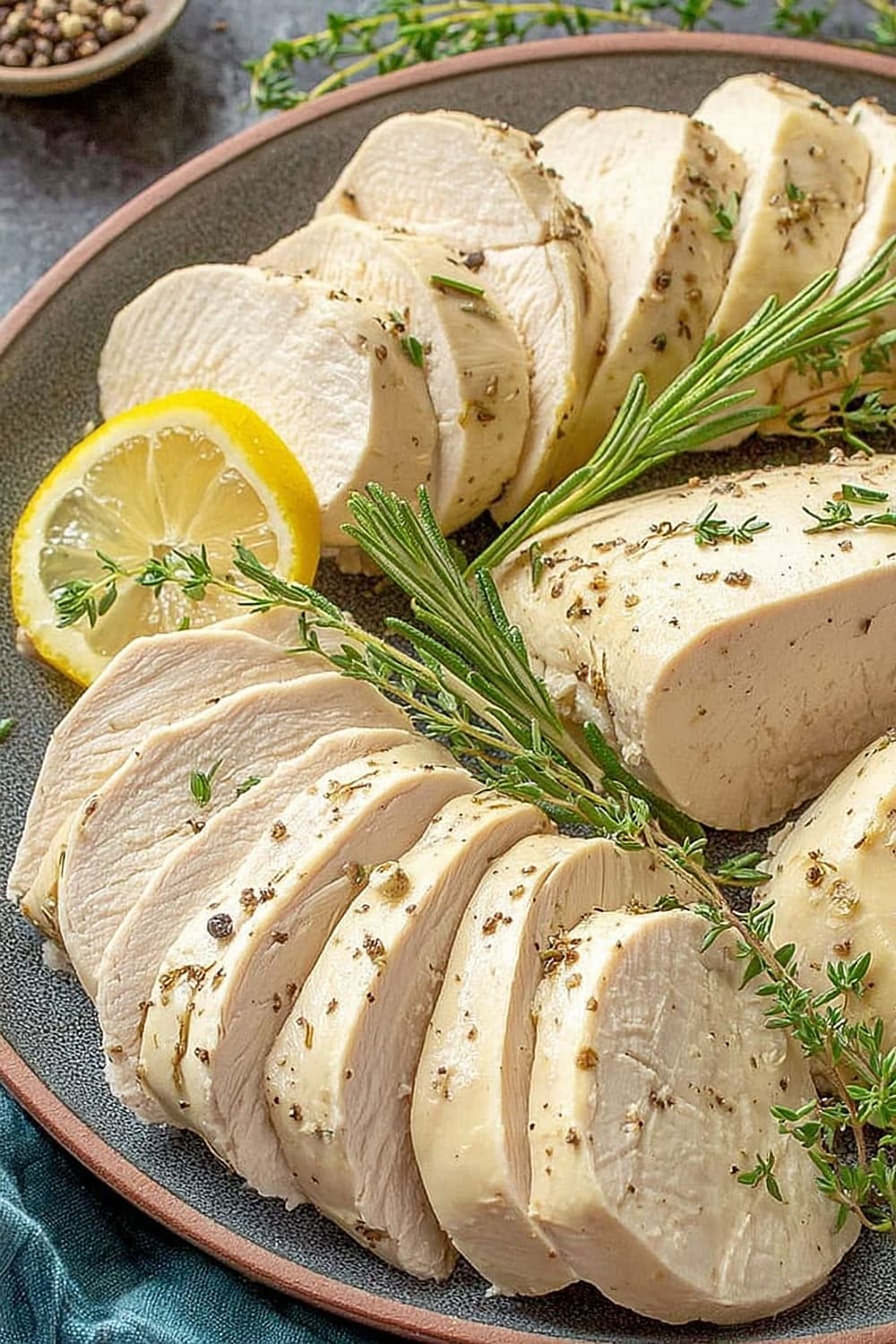
The gentle simmering creates the most incredibly tender, juicy chicken that practically falls apart with a fork, while the aromatic herbs infuse every bite with sophisticated flavor.
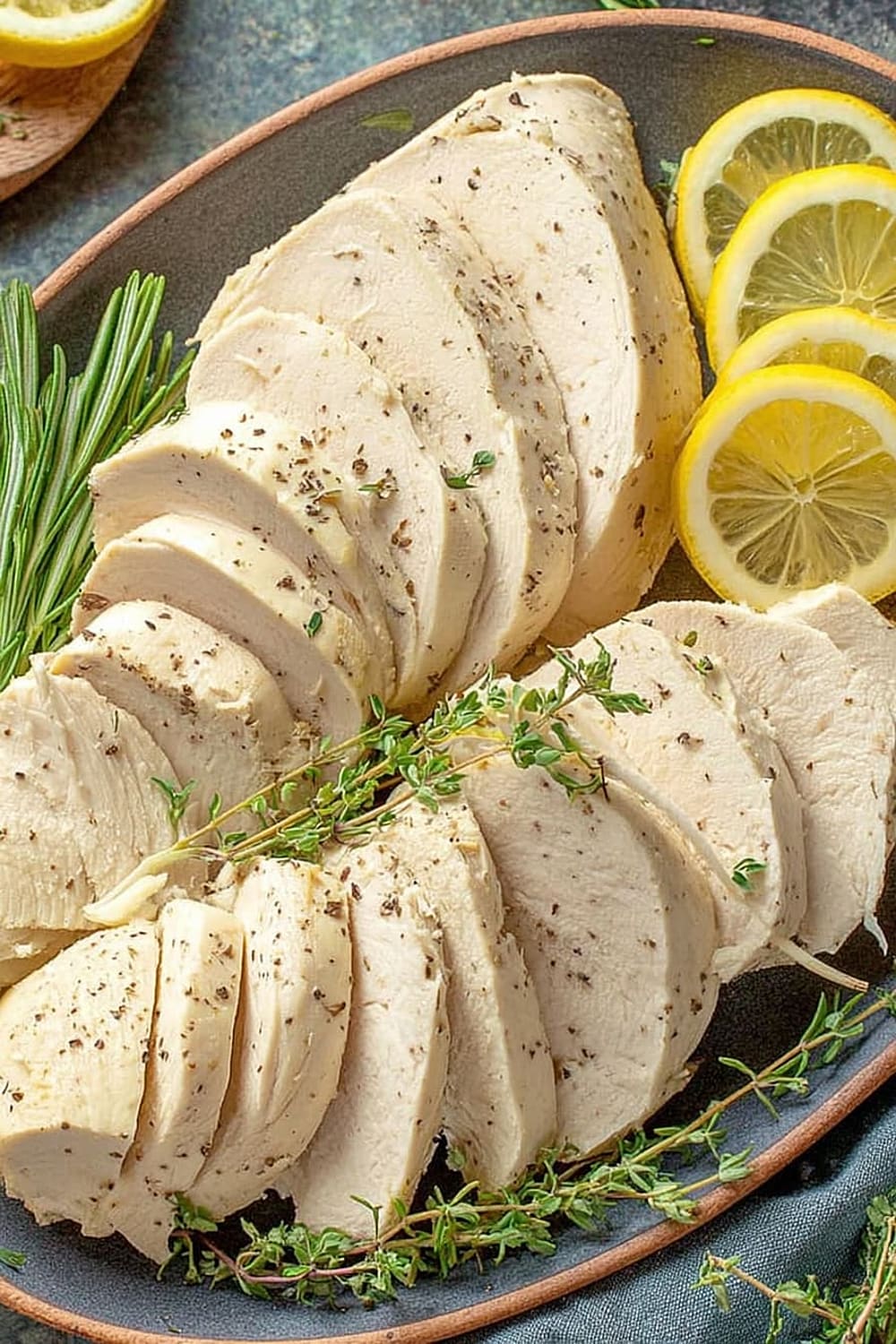
What makes this technique so brilliant is that it’s virtually impossible to overcook the chicken when you follow the temperature guidelines, giving you restaurant-quality results every single time.

The combination of white wine, fresh herbs, and aromatics creates a poaching liquid that’s basically a spa day for your chicken breasts.
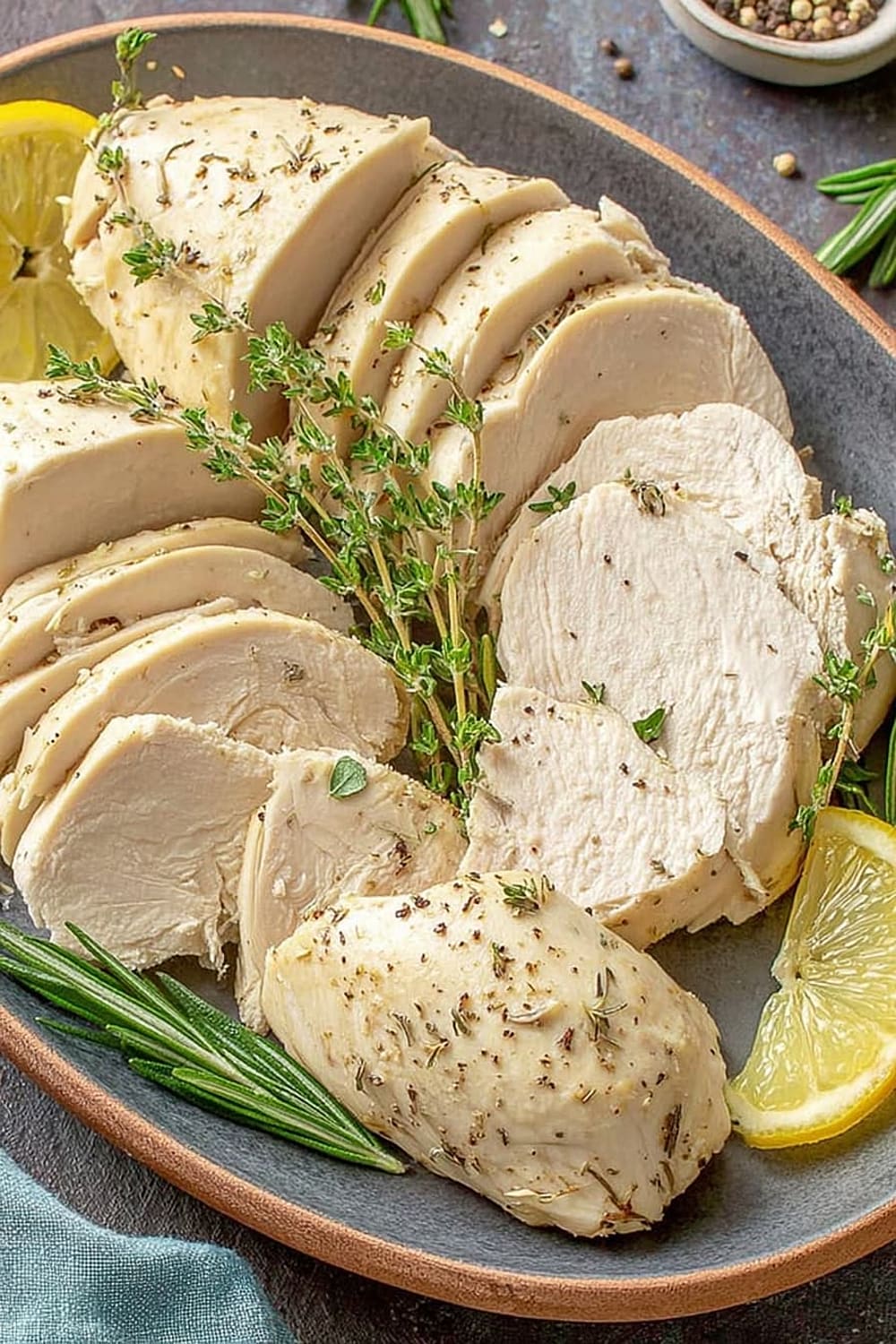
Plus, you’ll have leftover poaching liquid that makes an incredible base for soups, risottos, or gravy – it’s like getting two recipes for the price of one.
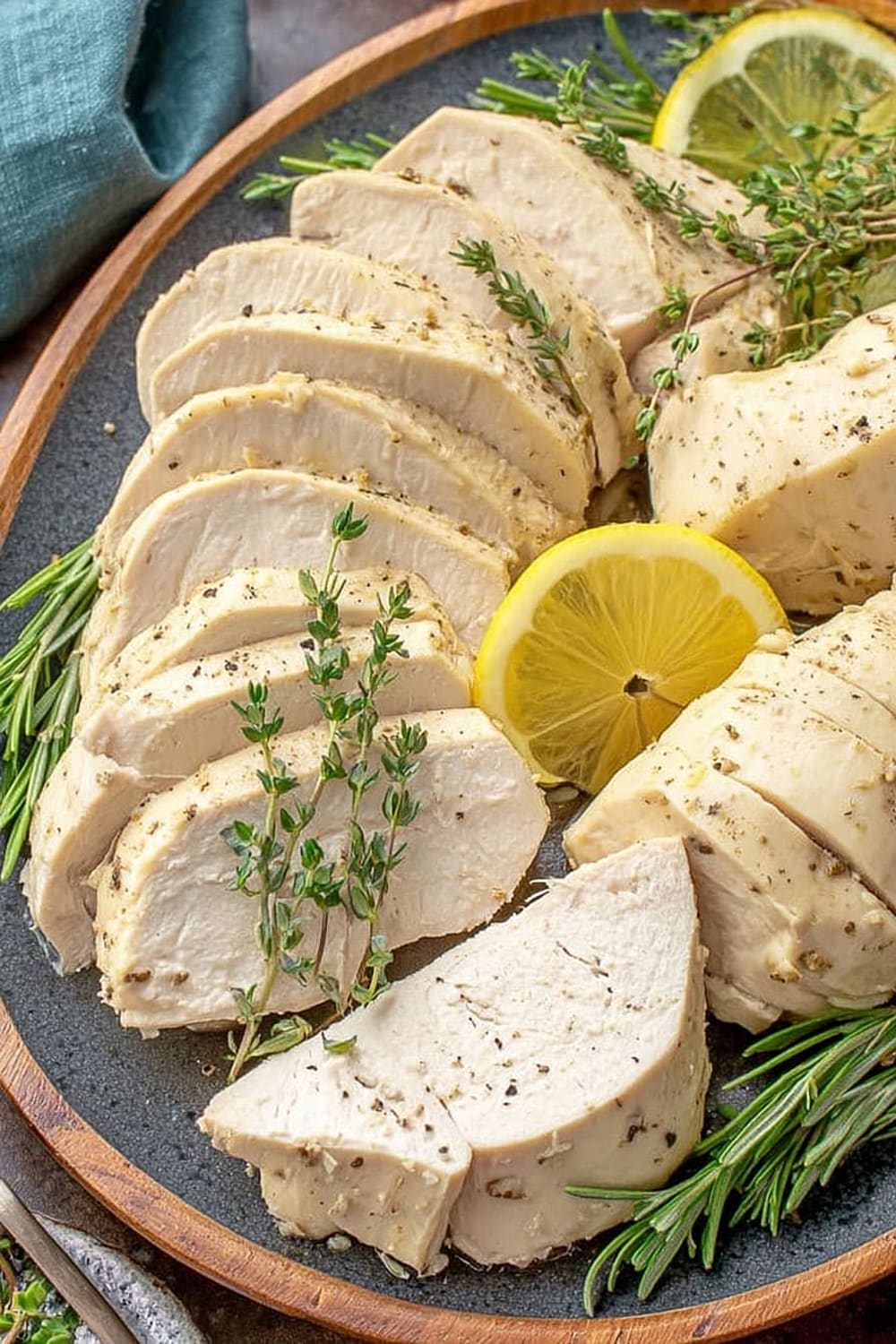
Ingredients
For the Chicken
- 4 boneless skinless chicken breasts (about 6 ounces each)
- Salt and pepper, to taste
For the Poaching Liquid
- 1 /2 cup white wine or light beer
- 6 whole peppercorns
- 3 fresh thyme sprigs
- 1 bay leaf
- 1 garlic clove, smashed
- 1 fresh rosemary sprig
- Cold water (enough to cover chicken by 1 inch)
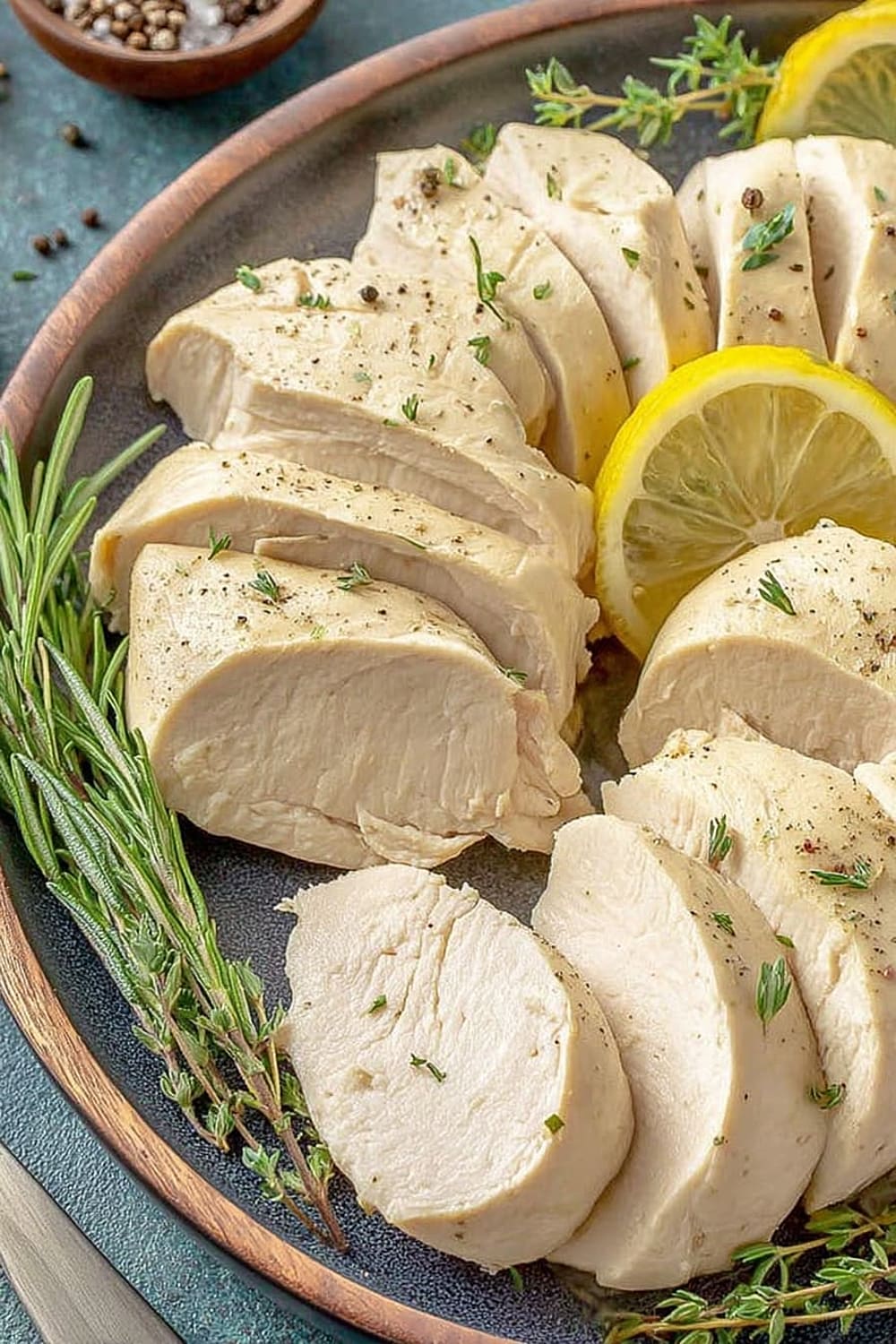
Instructions
Prepare the Poaching Setup
- 1 Place chicken breasts in a single layer in a high-sided sauté pan or wide, shallow pot. The pan should be large enough that the chicken breasts don’t overlap – this ensures even cooking and proper heat circulation.
- 2 Add the 1/2 cup white wine or light beer directly over the chicken. The alcohol will cook off during the process, leaving behind subtle depth of flavor that elevates the entire dish.
Create the Aromatic Base
- 3 Scatter the 6 whole peppercorns, 3 fresh thyme sprigs, 1 bay leaf, smashed garlic clove, and 1 fresh rosemary sprig around the chicken. Smashing the garlic clove releases more oils and flavor compounds than leaving it whole.
- 4 Pour in enough cold water to cover the chicken breasts by 1 inch. Starting with cold water allows the chicken to heat gradually, preventing the proteins from seizing up and becoming tough.
Execute the Poaching Process
- 5 Place the pan over medium heat and bring the liquid to a low simmer – you should see gentle bubbles breaking the surface occasionally, but no vigorous bubbling or rumbling. This is crucial: aggressive boiling will make the chicken tough and stringy.
- 6 Cook for 15-20 minutes or until the internal temperature of the thickest part of the chicken reaches 165°F (74°C) when tested with an instant-read thermometer. The exact timing depends on the thickness of your chicken breasts.
Finish and Rest
- 7 Use tongs to carefully transfer the chicken breasts to a plate or cutting board. Avoid using a fork, which can pierce the meat and release precious juices.
- 8 Let the chicken rest for 5 minutes before slicing. This resting period allows the juices to redistribute throughout the meat, ensuring maximum tenderness and flavor in every bite.
- 9 Season with salt and pepper as desired, then slice against the grain for the most tender texture.
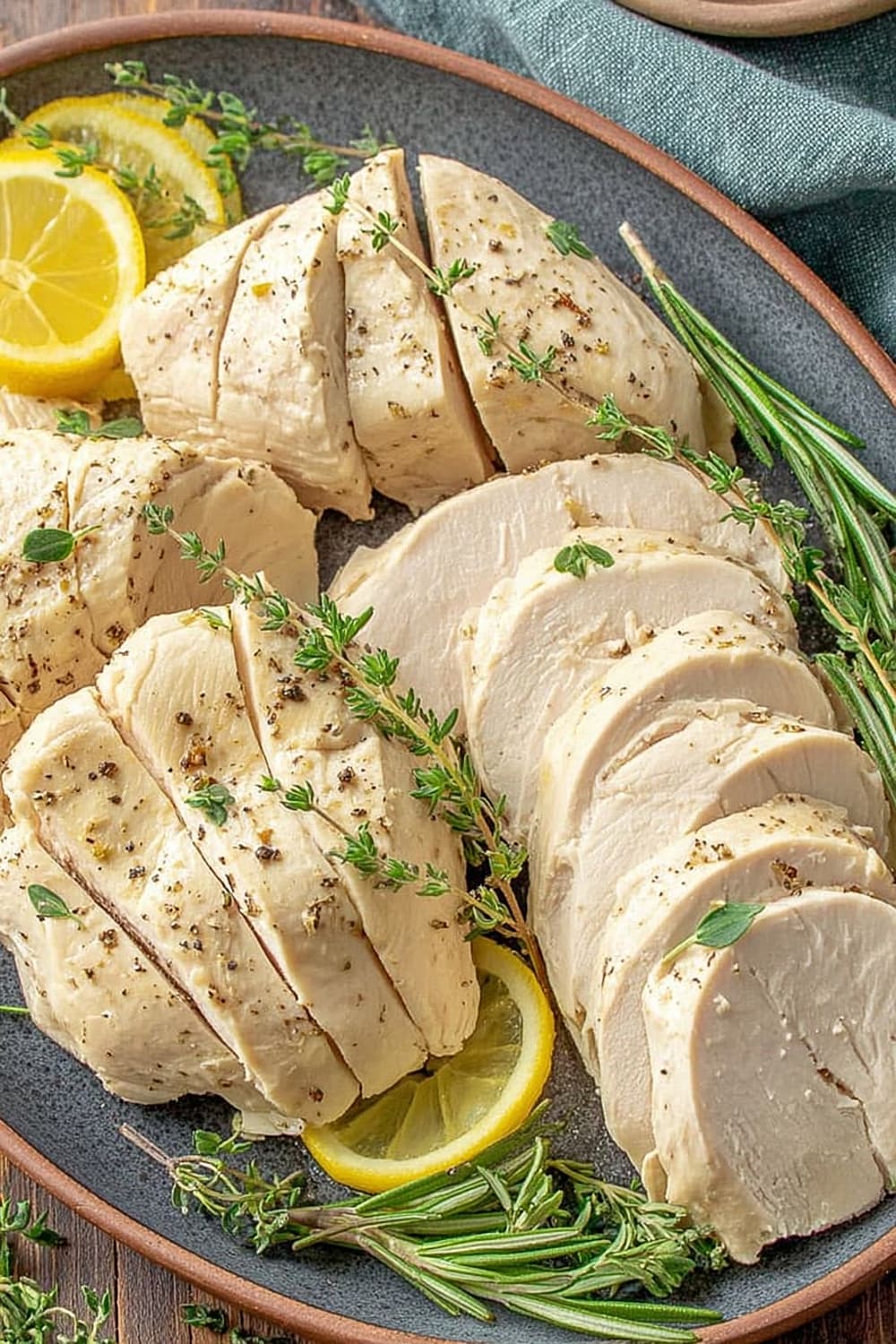
Recommended Equipment and Kitchen Tools
Essential Tools (for best results):
- High-sided sauté pan or wide shallow pot – Provides even heat distribution and prevents overcrowding
- Instant-read thermometer – Takes the guesswork out of doneness and prevents overcooking
- Tongs – Allow you to handle the chicken gently without piercing the meat
- Cutting board with juice groove – Catches any liquids during the resting period
Helpful Upgrades:
- Digital probe thermometer – Can stay in the chicken during cooking for continuous monitoring
- Fine-mesh strainer – Perfect for straining the poaching liquid if you want to use it for other recipes
- Kitchen scale – Ensures your chicken breasts are similar sizes for even cooking
- Silicone-tipped tongs – Won’t scratch your cookware and provide excellent grip
Nice-to-Have Options:
- Cast iron skillet – Excellent heat retention, though any heavy-bottomed pan works well
- Microplane grater – For zesting citrus or grating fresh garlic into the poaching liquid
- Storage containers – For saving that flavorful poaching liquid for future use
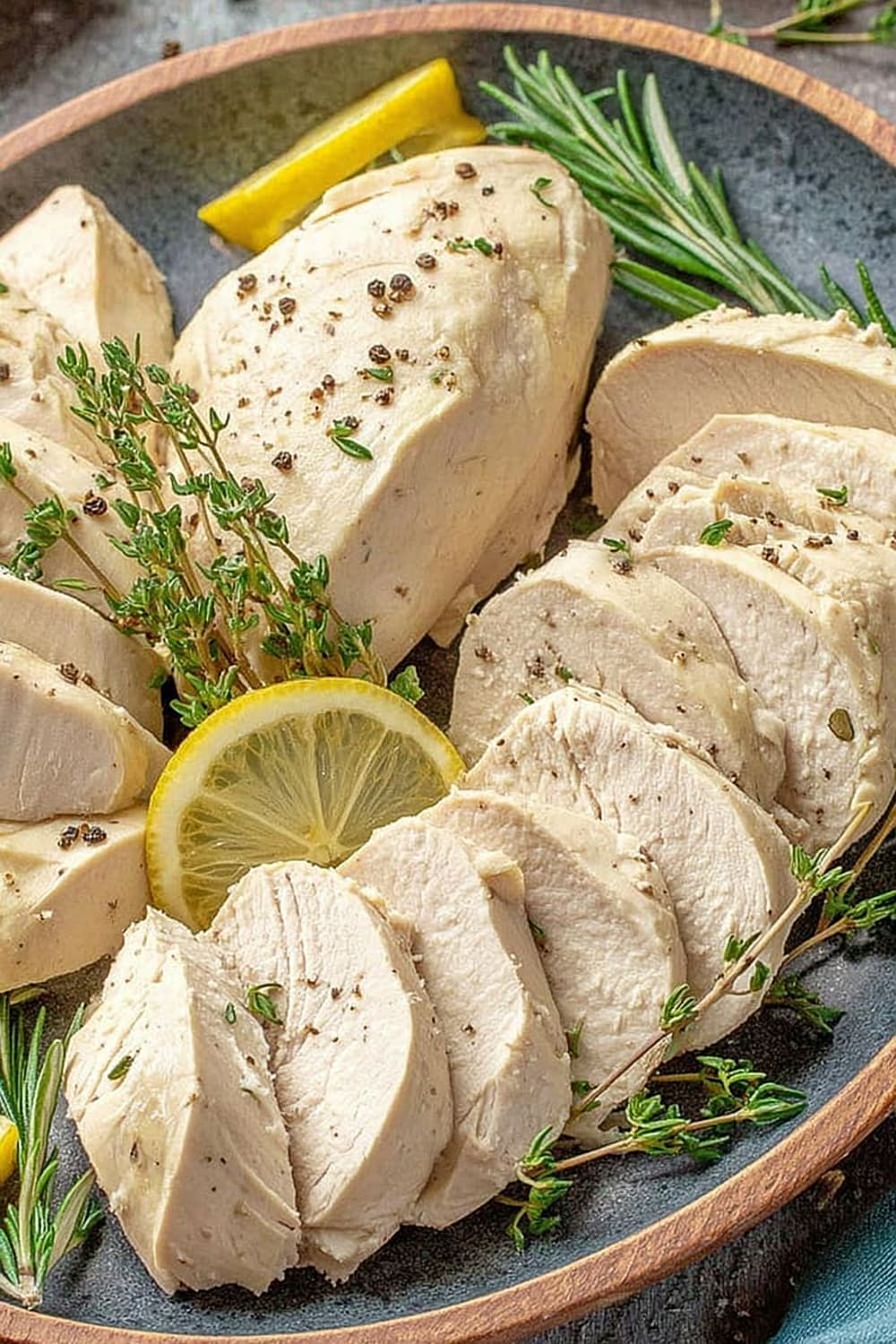
Recipe Variations and Dietary Modifications
Asian-Inspired Variation:
- Replace wine with rice wine or sake
- Add fresh ginger slices, star anise, and soy sauce
- Include scallions and cilantro in the poaching liquid
- Finish with sesame oil and lime juice
Mediterranean Style:
- Use white wine with oregano, basil, and lemon zest
- Add sun-dried tomatoes and olives to the poaching liquid
- Finish with extra virgin olive oil and fresh herbs
- Serve with roasted vegetables and couscous
Low-Sodium Modification:
- Replace wine with low-sodium chicken broth
- Use fresh herbs and citrus zest for flavor instead of salt
- Add celery, carrots, and onion to the poaching liquid
- Season with fresh lemon juice after cooking
Keto-Friendly Preparation:
- This recipe is naturally very low in carbs (under 2g per serving)
- Serve with cauliflower rice or zucchini noodles
- Top with avocado and olive oil for healthy fats
- Pair with leafy green salads and roasted low-carb vegetables
Meal Prep Version:
- Poach 6-8 chicken breasts at once in a larger pot
- Store in airtight containers with some poaching liquid
- Keeps refrigerated for 4-5 days
- Reheat gently or serve cold in salads

Nutritional Information and Health Benefits
Key Nutritional Highlights:
Each serving provides approximately 185 calories with 35 grams of high-quality protein and virtually no carbohydrates. The poaching method requires no added fats, making this an incredibly lean protein source that’s perfect for weight management and muscle building. The chicken provides all essential amino acids needed for optimal body function.
Health Benefits of Main Ingredients:
Chicken breast is an excellent source of niacin (vitamin B3), which supports brain function and helps convert food into energy. It’s also rich in selenium, a powerful antioxidant that supports immune function and thyroid health. The fresh herbs contribute antioxidants and anti-inflammatory compounds, while garlic provides allicin, known for its cardiovascular benefits and immune-boosting properties.
Dietary Considerations:
This recipe is naturally gluten-free, dairy-free, and low-carb, making it suitable for most dietary restrictions. It’s an excellent choice for paleo, keto, and Whole30 eating plans. The gentle cooking method preserves the chicken’s natural nutrients while creating an easily digestible protein source. Each serving contains approximately 0.5 grams of sodium when prepared without additional salt.

Smart Swaps and Ingredient Substitutions
Wine and Liquid Substitutions:
- White wine → Chicken broth or vegetable broth (use same amount)
- Light beer → Apple cider or white grape juice (adds subtle sweetness)
- Water → Coconut water (provides natural electrolytes and mild flavor)
Herb and Aromatic Swaps:
- Fresh thyme → Dried thyme (use 1 teaspoon instead of 3 sprigs)
- Fresh rosemary → Dried rosemary (use 1/2 teaspoon, crushed)
- Bay leaf → Dried oregano or marjoram (1/2 teaspoon)
- Garlic clove → Garlic powder (1/4 teaspoon) or shallot (1 small, sliced)
Chicken Alternatives:
- Chicken thighs → Increase cooking time to 20-25 minutes for bone-in
- Turkey breast → Same cooking method, check for 165°F (74°C)
- Fish fillets → Reduce cooking time to 8-12 minutes depending on thickness
Pro Tips for Substitutions:
- Dried herbs are more concentrated than fresh – use about 1/3 the amount
- Bone-in chicken requires longer cooking but stays more moist
- Save the poaching liquid – it makes excellent soup base or cooking liquid for rice

Make It Diabetes-Friendly
Carb Content Analysis:
- This recipe contains less than 2 grams of carbohydrates per serving
- The wine contributes minimal residual sugars that cook off during the process
- Total net carbs: approximately 1 gram per serving
Blood Sugar Benefits:
- High protein content helps stabilize blood sugar levels
- No added sugars or high-glycemic ingredients
- Lean protein supports steady energy without glucose spikes
- Portion control is naturally built in with individual chicken breasts
Serving Suggestions for Diabetics:
- Pair with non-starchy vegetables like broccoli, asparagus, or green beans
- Serve over cauliflower rice instead of regular rice
- Add healthy fats like avocado or olive oil to increase satiety
- Recommended serving size: 1 chicken breast (6 ounces) provides sustained energy
Meal Timing Tips:
- Excellent for lunch or dinner when you need reliable protein
- Pre-workout meal provides sustained energy without sugar crash
- Post-workout recovery supports muscle repair with complete amino acids

Perfect Pairing Suggestions
Beverage Pairings:
White wines like Sauvignon Blanc or Pinot Grigio complement the delicate flavors without overwhelming the subtle herb notes. For beer lovers, a light lager or wheat beer pairs beautifully. Non-alcoholic options include sparkling water with lemon, herbal teas like chamomile or mint, or cucumber-infused water for a spa-like experience.
Side Dish Recommendations:
Roasted seasonal vegetables provide textural contrast – try asparagus with lemon, roasted Brussels sprouts, or honey-glazed carrots. Wild rice pilaf or quinoa add nutty flavors and complete proteins. Fresh salads with mixed greens, cherry tomatoes, and balsamic vinaigrette create a light, refreshing meal. Garlic mashed cauliflower offers comfort food satisfaction with fewer carbs.
Complete Meal Ideas:
Start with a simple green salad or vegetable soup to awaken the palate. The poached chicken pairs beautifully with Mediterranean flavors – serve with roasted vegetables, couscous, and tzatziki sauce. For casual dining, slice the chicken over grain bowls with roasted sweet potatoes and tahini dressing. Elegant presentations might include herb-crusted potatoes and sautéed spinach with lemon butter.
Occasion Suggestions:
Perfect for meal prep Sundays, light summer dinners, or post-workout meals. The elegant simplicity makes it ideal for dinner parties where you want to focus on conversation rather than complicated cooking. Weeknight family dinners become effortless with this reliable technique.
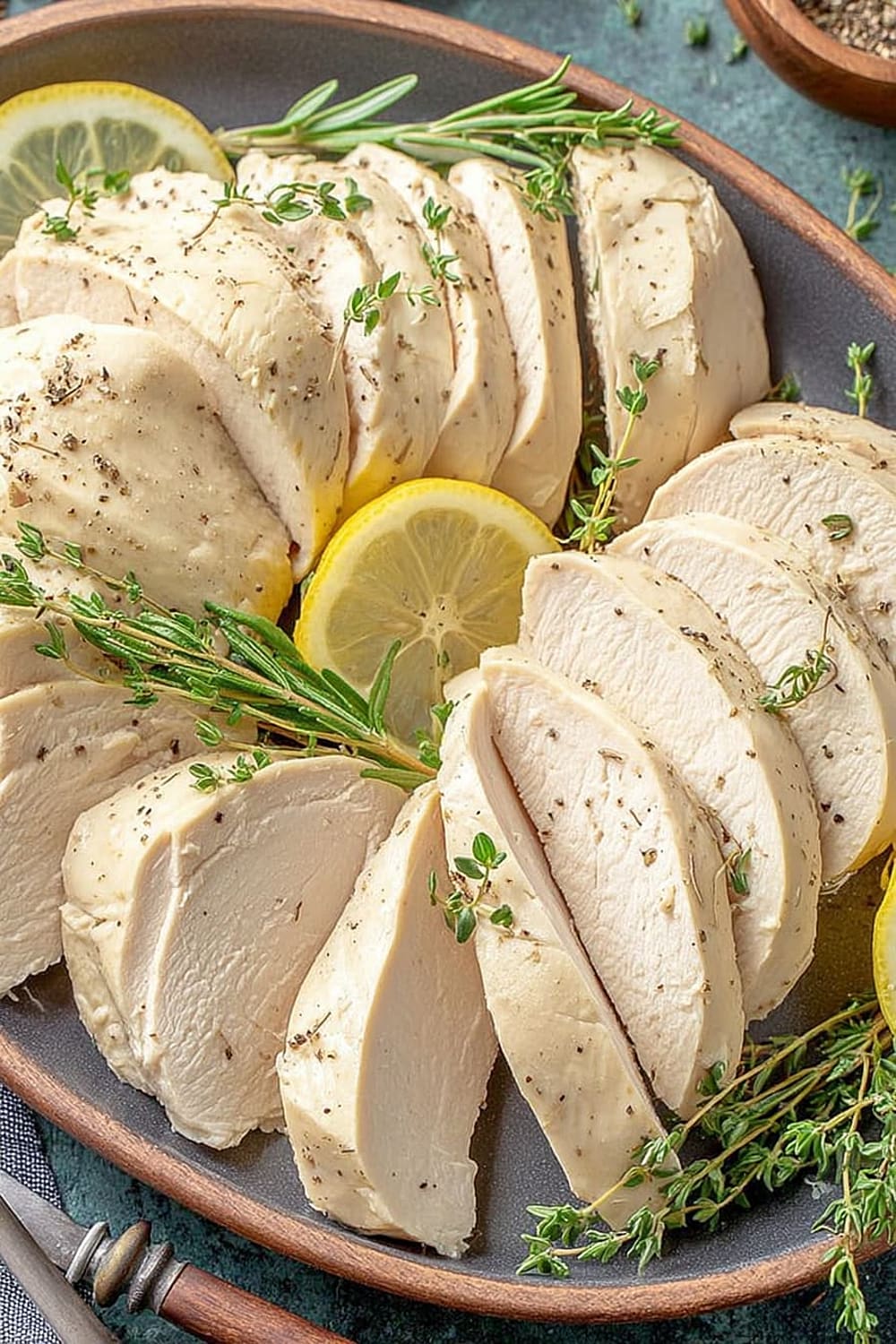
Pro Tips and Troubleshooting
Professional Poaching Secrets:
Start with room temperature chicken for more even cooking – take it out of the refrigerator 20 minutes before cooking. Pound thicker portions to ensure uniform thickness, which prevents overcooking thin areas while thick sections finish. Salt the poaching liquid lightly to enhance flavor penetration, but avoid over-salting since the liquid reduces during cooking.
Common Mistakes and Solutions:
Boiling instead of simmering creates tough, stringy chicken – keep the heat low and look for gentle bubbles, not vigorous boiling. Overcrowding the pan leads to uneven cooking – work in batches if necessary. Skipping the resting period results in dry chicken as juices haven’t redistributed. Not using a thermometer often leads to overcooked, dry results.
Storage and Reheating:
Store sliced chicken in the refrigerator for 4-5 days with some reserved poaching liquid to maintain moisture. Freeze portions for up to 3 months in airtight containers. Reheat gently in the microwave with a splash of broth, or serve cold in salads and sandwiches. The poaching liquid keeps for 1 week refrigerated and makes excellent soup base.
Scaling and Make-Ahead Strategies:
Double or triple the recipe using a larger pot – cooking time remains the same. Prepare the aromatics in advance and store in the refrigerator. Pre-portion chicken breasts and freeze with seasoning for quick weeknight meals. Batch cook on weekends for easy meal prep throughout the week.

This foolproof poaching method transforms ordinary chicken breasts into restaurant-quality protein that’s tender, flavorful, and incredibly versatile. Whether you’re meal prepping for the week, preparing an elegant dinner, or simply want perfectly cooked chicken every time, this technique delivers consistent results that will make you wonder why you ever struggled with dry, overcooked chicken again.